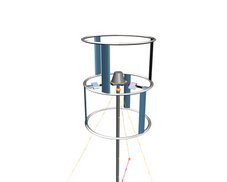If you track cleantech, you've quickly come across nameplates. These are the standard metric used for indicating the power output of any renewable energy system that produces electric power. A typical solar panel will be rated and sold as "120 watts", or a wind turbine as a "3 kw" turbine. These power ratings are known as the system's "nameplate" value.
But what does this nameplate actually mean?
The nameplate is the peak power production the panel/turbine/system is capable of producing. By peak, it's meant to indicate the maximum power, but it also requires "best" conditions, e.g. 120 watts will come from this panel at noon, on a clear skies day, in New Mexico, on June 21rst with the panel at an optimum operating temperature. Now, if you don't happen to live in New Mexico, or it isn't noon, or it's cloudy, or the panel is overheated, that panel could produce that power, less power or no power depending on conditions. In other words, you buy the solar panel as a 120 watt nameplate power output, but you will only get it's peak power output for a limited range of irradiance, temperature, angle of incidence, etc.
In wind power, a 3 kw system will produce 3 kilowatts when the wind is blowing at a certain speed, typically but not always 11 meters per second. While that 11 m/s is an industry norm and AWEA recommendation, some leading vendors in wind turbine market still "cheat" - labelling 3 kW on systems that requires 13 or 14 m/s. That may not seem like much of a trick, but in reality, most wind sites will have 14 m/s winds 2% as often as 11 m/s winds. And in wind power, where power delivered is the CUBE of wind speed, a spare 3 meters a second means you get HALF as much power as you thought.
As the following graphic demonstrates, the same nameplate turbines will deliver substantially different total power outputs based on their overall efficiencies in different wind speeds. You care about the volume UNDER the curves, but the nameplate is simply the peak power produced at the top right hand side of these curves. Quite literally, two turbines with 3kw nameplates could deliver 3000 OR 6000 kw/hrs in a given year at the same install.
So what?
Hopefully, I've shown that nameplates for renewable power are a nearly useless metric. They don't tell you anything except an ideal condition you won't experience often and are a hangover from when a maximum power output was something you could literally "flip on" on demand in gas-fired and coal electric plants. Renewables don't work that way.
Far more useful than "nameplates" would be a way to tell you what kind of total power delivery you will get from a system. That is after all, the most important metric for any power system.
Unfortunately, that's much easier said than done. In solar panels, you'll first need to know the panel's power curve- essentially the sum of all the power outputs the panel is able to produce across the sun rising to sinking in the day. To calculate a yearly power output for the panel would be even more useful, as the sun moves through different angles of incidence for that panel depending on the calendar, and you'll need to factor in region-specific degrees of cloudy days.
In wind, a similar power curve exists that begins with the cut-in wind speed (what speed do you start generating power), and increments power delivery up to the peak capacity speed in a curve. Luckily for wind, there are not quite as many variables to factor. Unfortunately, the power output calculations are made more complex by the higher degree of wind speed variability at any given location.
We need a new power metric.
Wednesday, March 21, 2007
On Nameplates and Industry Metrics, Part One
Posted by
Jeremy Stieglitz
at
2:56 PM
![]()
Labels: VAWT technology
Subscribe to:
Comment Feed (RSS)




|